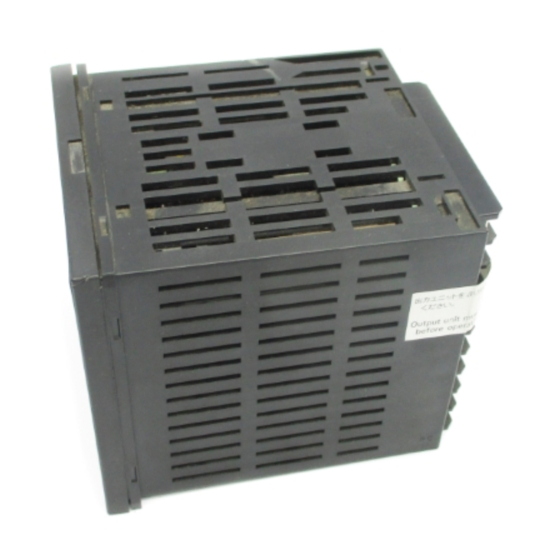
Table of Contents
Advertisement
Quick Links
Advertisement
Chapters
Table of Contents
Troubleshooting

Summarization of Contents
Section 1 Introduction
1-1 Features
Basic features of the Thermac E5J Temperature Controller.
1-2 Models
Describes the thermocouples and platinum resistance thermometers that can be connected.
1-3 Specifications
Details various specifications including supply voltage, power consumption, input types, and output units.
Section 2 Sensor and Mode Settings
2-1 Disassembly
Instructions on how to disassemble the unit to access internal settings.
2-2 Output Units
Describes available output units and their connection to the controller.
2-3 Internal Switch Settings
Details the settings of internal switches for various functions and modes.
Section 3 Settings Before Operation
3-1 Nomenclature
Identifies the components and indicators on the front panel of the controller.
3-2 Setting Flowchart
Illustrates the procedure for setting parameters across different display levels.
3-3 List of Parameters
Provides a comprehensive list of parameters, their ranges, and default settings.
3-4 Parameters on Display Level 0
Describes parameters accessible at Display Level 0, like set point and alarm settings.
3-5 Parameters on Display Level 1
Details parameters available at Display Level 1, including control period and hysteresis.
Section 4 Fuzzy Self-tuning
4-1 Fuzzy Self-tuning Operation
Explains the three features of fuzzy self-tuning: SRT, DT, and HT.
4-2 Troubleshooting
Provides guidance for troubleshooting issues with fuzzy self-tuning or smooth operation.
4-3 Terminology
Defines key terms used in fuzzy self-tuning and control operation.
Section 5 Installation and Wiring
5-1 Installation
Covers recommended installation locations and mounting methods for the controller.
5-2 Wiring
Provides instructions and precautions for wiring the temperature controller.
5-3 Terminal Arrangement
Details the terminal layout and connections for different controller models.
Section 6 Troubleshooting
6-1 Error Display and Output
Lists potential errors, their display, and corresponding output states.
6-2 Troubleshooting
Offers solutions for common operational issues and phenomena.
Section 7 Event Input Function
7-1 Event Input Function
Explains how event input functions operate for set point and RUN/STOP selection.
Section 8 Heater Burnout Detection
8-1 Heater Burnout Detection
Describes the principle of detecting heater burnout using a current transformer.
8-2 Heater Burnout Procedures
Outlines steps for detecting and resetting heater burnout alarms.
8-3 Wiring the Current Transformer
Shows the wiring diagram for connecting the current transformer to the controller.
8-4 Heater Burnout Alarm Value
Explains how to set the heater burnout alarm value for detection.
Section 9 Engineering Level Settings
9-1 Engineering Level
Explains how to access the engineering level for advanced settings.
9-2 Engineering Level Parameter List
Lists available parameters in the engineering level with their settings.
9-3 Engineering Level Parameters
Details specific engineering level parameters and their functions.
Section 10 Auto-tuning
10-1 Starting Auto-tuning
Describes the procedure to initiate the auto-tuning process.
10-2 Conditions that Prevent Auto-tuning
Lists conditions that will prevent auto-tuning from starting.
10-3 Force-ending Auto-tuning
Explains how auto-tuning can be forcibly terminated.
10-4 Changing Parameters during Auto-tuning
Discusses parameter changes that can or cannot be made during auto-tuning.
Appendix A Dimensions/Mounting Holes
E5AJ Dimensions
Provides dimensional drawings and mounting hole specifications for the E5AJ model.
E5EJ Dimensions
Provides dimensional drawings and mounting hole specifications for the E5EJ model.
E5CJ Dimensions
Provides dimensional drawings and mounting hole specifications for the E5CJ model.
Terminal Covers
Shows dimensions for terminal cover accessories.
















Need help?
Do you have a question about the E5CJ-R and is the answer not in the manual?
Questions and answers